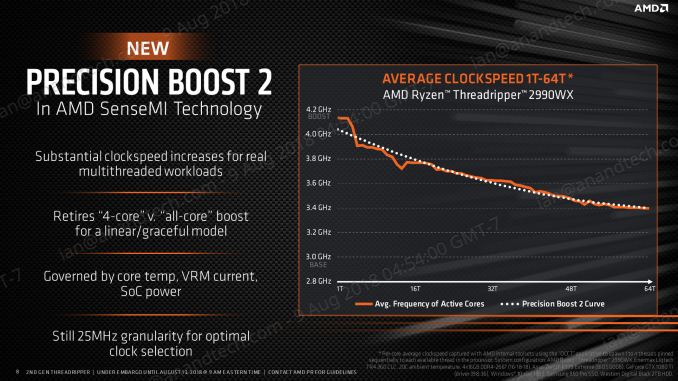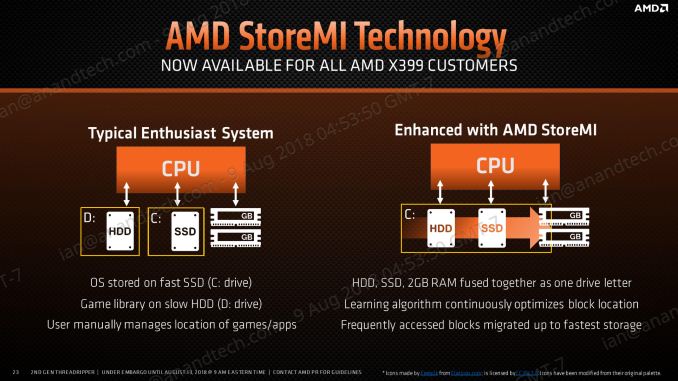The AMD Threadripper 2990WX 32-Core and 2950X 16-Core Review
by Dr. Ian Cutress on August 13, 2018 9:00 AM ESTPrecision Boost 2
Exact per-core turbo timings for the new processors will be determined by AMD’s voltage-frequency scaling functionality through Precision Boost 2. This feature, which we covered extensively in our Ryzen 7 2700X review, relies on available power and current to determine frequency, rather than a discrete look-up-table for voltage and frequency based on loading. Depending on the system default capabilities, the frequency and voltage will dynamically shift in order to use more of the power budget available at any point in the processor loading.
The idea is that the processor can use more of the power budget available to it than a fixed look up table that has to be consistent between all SKUs that are stamped with that number.
Precision Boost 2 also works in conjunction with XFR2 (eXtreme Frequency Range) which reacts to additional thermal headroom. If there is additional thermal budget, driven by a top-line cooler, then the processor is enabled to use more power up to the thermal limit and get additional frequency. AMD claims that a good cooler in a low ambient situation can compute >10% better in selected tests as a result of XFR2.
Ultimately this makes testing Threadripper 2 somewhat difficult. With a turbo table, performance is fixed between the different performance characteristics of each bit of silicon, making power the only differentiator. With PB2 and XF2, no two processors will perform the same. AMD has also hit a bit of a snag with these features, choosing to launch Threadripper 2 during the middle of a heatwave in Europe. Europe is famed for its lack of air conditioning everywhere, and when the ambient temperature is going above 30ºC, this will limit additional performance gains. It means that a review from a Nordic publication might see better results than one from the tropics, quite substantially.
Luckily for us we tested most of our benchmarks while in an air conditioned hotel thanks to Intel’s Data-Centric Innovation Summit which was the week before launch.
Precision Boost Overdrive
The new processors also support a feature called Precision Boost Overdrive, which looks at three key areas for power, thermal design current, and electrical design current. If any of these three areas has additional headroom, then the system will attempt to raise both the frequency and the voltage for increased performance. PBO is a mix of ‘standard’ overclocking, giving an all core boost, but gives a single core frequency uplift along with the support to still keep Precision Boost trying to raise frequency in middle-sized workloads, which is typically lost with a standard overclock. PBO also allows for idle power saving with a standard performance. PBO is enabled through Ryzen Master.
The three key areas are defined by AMD as follows:
- Package (CPU) Power, or PPT: Allowed socket power consumption permitted across the voltage rails supplying the socket
- Thermal Design Current, or TDC: The maximum current that can be delivered by the motherboard voltage regulator after warming to a steady-state temperature
- Electrical Design Current, or EDC: The maximum current that can be delivered by the motherboard voltage regulator in a peak/spike condition
By extending these limits, PBO gives rise for PB2 to have more headroom, letting PB2 push the system harder and further. PBO is quoted by AMD as supplying up to +16% performance beyond the standard.
AMD also clarifies that PBO is pushing the processor beyond the rated specifications and is an overclock: and thus any damage incurred will not be protected by warranty
StoreMI
Also available with the new Ryzen Threadripper 2 processors is StoreMI, AMD’s solution to caching by offering configurable tiered storage for users that want to mix DRAM, SSD, and HDD storage into a single unified platform. The software implementation dynamically adjusts data between up to 2GB of DRAM, up to 256 GB of SSD (NVMe or SATA), and a spinning hard drive to afford the best reading and writing experience when there isn’t enough fast storage.
AMD initially offered this software as a $20 add-on to the Ryzen APU platform, then it became free (up to a 256GB SSD) for the Ryzen 2000-series processors. That offer now extends to Threadripper. AMD’s best case scenario is citing a 90% improvement in loading times.













171 Comments
View All Comments
jospoortvliet - Saturday, August 18, 2018 - link
https://www.phoronix.com/scan.php?page=article&... has some.nul0b - Monday, August 13, 2018 - link
Ian please define how exactly you're calculating and deriving uncore and IF power utilization.alpha754293 - Monday, August 13, 2018 - link
I vote that from now on, all of the CPU reviews should be like this.Just raw data.
Lolimaster - Monday, August 13, 2018 - link
To resume:Intel's TDP is a blatant lie, it barely keeps at TDP at 6c/6t, meanwhile AMD stick on point or below TDP with their chips, boost included :D
Lolimaster - Monday, August 13, 2018 - link
Selling more shares from $1.65 now to $19 :DAMD Threadripper 2, ripping the blue hole.
Lolimaster - Monday, August 13, 2018 - link
It seems geekbench can't scale beyond 16cores.Lolimaster - Monday, August 13, 2018 - link
WHERE IS CINEBENCH?Lolimaster - Monday, August 13, 2018 - link
And I mean CB15Also, for some reason CB11.5 MT seems to be broken for TR, it stops caling at 12cores.
mapesdhs - Monday, August 13, 2018 - link
CB R15 is suffering issues aswell these days, at this level it can exhibit huge variance from one run to another.eastcoast_pete - Monday, August 13, 2018 - link
Thanks Ian, great article, look forward to seeing the full final version!My conclusions: All these are workstation processors, NOT for gaming; the Ryzen 2700X and the upcoming Intel octacore 9000 series are/will be better for gaming, both in value for money and absolute performance. That being said, the TR 2950X could be a great choice, if your productivity software can make good use of the 16 cores/32 threads, and if that same software isn't written to make strong use of AVX 512. If the applications that you buy these monsters can make heavy use of AVX 512, Intel's chips are currently hard or impossible to beat, even at the same price point. That being said, a 2950X workstation with 128 or 256 Gb of RAM (in quad channel, of course), plus some fast PCIe/NVMe SSDs and a big & fast graphics card would make an awesome video editing setup; and, the 60 PCIe channels would come in really handy for add-in boards. One fly in the ointment: AMD, since you're hamstringing TR with only quad-channel, at least let us use faster DDR4; how about officially supporting > 3.2 Ghz?
Unrelated: Love the testing setup where the system storage SSD ( 1TB) is the same size as the working memory (1 TB). With one of these, you know you're in the heavyweight division.
@Ian: I also really appreciate the testing of power draws by cores vs. interconnecting fabric. I also believe (as you wrote) that this is a much underappreciated hurdle in simply escalating the number of cores. I also wonder a. How is that affecting ARM-based multicore chips, especially once we are talking 32 cores and up, as for the chips intended for servers? and b. Is that one of the reasons (or THE reason) why ARM-based manycore solutions have not been getting much traction, and why companies like Qualcomm have stopped their development? Yes, the cores might be very efficient, but if those power savings are being gobbled up by the interconnects, fewer but broader and deeper cores might still end up winning the performance/wh race.
If you and/or Ryan (or any of your colleagues) could do a deep dive into the general issue of power use by the interconnecting fabric and the different architectures, I would really appreciate it.